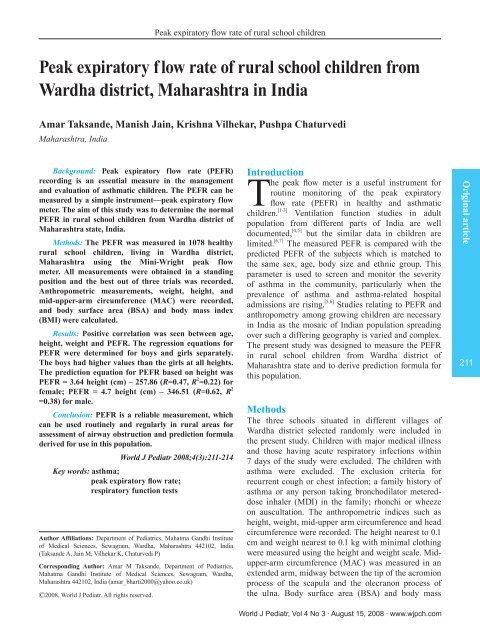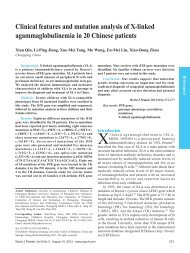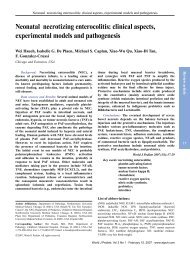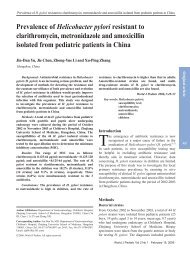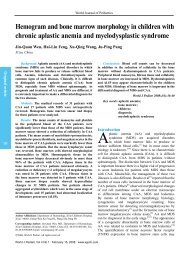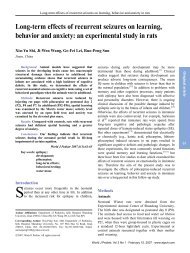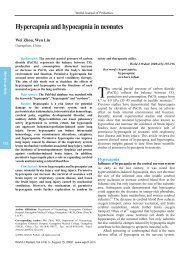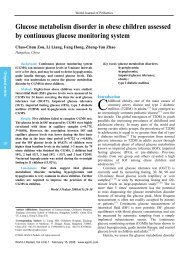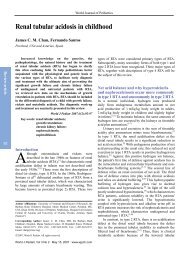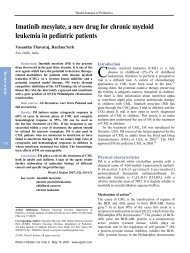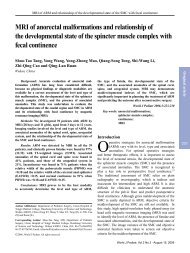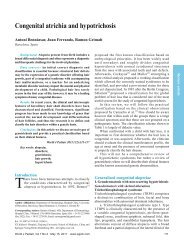Peak expiratory f low rate of rural school children from Wardha ...
Peak expiratory f low rate of rural school children from Wardha ...
Peak expiratory f low rate of rural school children from Wardha ...
You also want an ePaper? Increase the reach of your titles
YUMPU automatically turns print PDFs into web optimized ePapers that Google loves.
Background: <strong>Peak</strong> <strong>expiratory</strong> f<strong>low</strong> <strong>rate</strong> (PEFR)<br />
recording is an essential measure in the management<br />
and evaluation <strong>of</strong> asthmatic <strong>children</strong>. The PEFR can be<br />
measured by a simple instrument— peak <strong>expiratory</strong> f<strong>low</strong><br />
meter. The aim <strong>of</strong> this study was to determine the normal<br />
PEFR in <strong>rural</strong> <strong>school</strong> <strong>children</strong> <strong>from</strong> <strong>Wardha</strong> district <strong>of</strong><br />
Maharashtra state, India.<br />
Methods: The PEFR was measured in 1078 healthy<br />
<strong>rural</strong> <strong>school</strong> <strong>children</strong>, living in <strong>Wardha</strong> district,<br />
Maharashtra using the Mini-Wright peak f<strong>low</strong><br />
meter. All measurements were obtained in a standing<br />
position and the best out <strong>of</strong> three trials was recorded.<br />
Anthropometric measurements, weight, height, and<br />
mid-upper-arm circumference (MAC) were recorded,<br />
and body surface area (BSA) and body mass index<br />
(BMI) were calculated.<br />
Results: Positive correlation was seen between age,<br />
height, weight and PEFR. The regression equations for<br />
PEFR were determined for boys and girls sepa<strong>rate</strong>ly.<br />
The boys had higher values than the girls at all heights.<br />
The prediction equation for PEFR based on height was<br />
PEFR = 3.64 height (cm) – 257.86 (R=0.47, R 2 =0.22) for<br />
2<br />
female; PEFR = 4.7 height (cm) – 346.51 (R=0.62,<br />
=0.38) for male.<br />
Author Affi liations: Department <strong>of</strong> Pediatrics, Mahatma Gandhi Institute<br />
<strong>of</strong> Medical Sciences, Sewagram, <strong>Wardha</strong>, Maharashtra 442102, India<br />
(Taksande A, Jain M, Vilhekar K, Chaturvedi P)<br />
Corresponding Author: Amar M Taksande, Department <strong>of</strong> Pediatrics,<br />
Mahatma Gandhi Institute <strong>of</strong> Medical Sciences, Sewagram, <strong>Wardha</strong>,<br />
Maharashtra 442102, India (amar_bharti2000@yahoo.co.uk)<br />
©2008, World J Pediatr. All rights reserved.<br />
<strong>Peak</strong> <strong>expiratory</strong> fl ow <strong>rate</strong> <strong>of</strong> <strong>rural</strong> <strong>school</strong> <strong>children</strong><br />
<strong>Peak</strong> <strong>expiratory</strong> f <strong>low</strong> <strong>rate</strong> <strong>of</strong> <strong>rural</strong> <strong>school</strong> <strong>children</strong> <strong>from</strong><br />
<strong>Wardha</strong> district, Maharashtra in India<br />
Amar Taksande, Manish Jain, Krishna Vilhekar, Pushpa Chaturvedi<br />
Maharashtra, India<br />
Conclusion: PEFR is a reliable measurement, which<br />
can be used routinely and regularly in <strong>rural</strong> areas for<br />
assessment <strong>of</strong> airway obstruction and prediction formula<br />
derived for use in this population.<br />
World J Pediatr 2008;4(3):211-214<br />
Key words: asthma;<br />
peak <strong>expiratory</strong> fl ow <strong>rate</strong>;<br />
respiratory function tests<br />
Introduction<br />
The peak fl ow meter is a useful instrument for<br />
routine monitoring <strong>of</strong> the peak <strong>expiratory</strong><br />
fl ow <strong>rate</strong> (PEFR) in healthy and asthmatic<br />
<strong>children</strong>. [1-3] Ventilation function studies in adult<br />
population <strong>from</strong> different parts <strong>of</strong> India are well<br />
documented, [4,5] but the similar data in <strong>children</strong> are<br />
limited. [6,7] The measured PEFR is compared with the<br />
predicted PEFR <strong>of</strong> the subjects which is matched to<br />
the same sex, age, body size and ethnic group. This<br />
parameter is used to screen and monitor the severity<br />
<strong>of</strong> asthma in the community, particularly when the<br />
prevalence <strong>of</strong> asthma and asthma-related hospital<br />
admissions are rising. [5,6] Studies relating to PEFR and<br />
anthropometry among growing <strong>children</strong> are necessary<br />
in India as the mosaic <strong>of</strong> Indian population spreading<br />
over such a differing geography is varied and complex.<br />
The present study was designed to measure the PEFR<br />
in <strong>rural</strong> <strong>school</strong> <strong>children</strong> <strong>from</strong> <strong>Wardha</strong> district <strong>of</strong><br />
Maharashtra state and to derive prediction formula for<br />
this population.<br />
Methods<br />
The three <strong>school</strong>s situated in different villages <strong>of</strong><br />
<strong>Wardha</strong> district selected randomly were included in<br />
the present study. Children with major medical illness<br />
and those having acute respiratory infections within<br />
7 days <strong>of</strong> the study were excluded. The <strong>children</strong> with<br />
asthma were excluded. The exclusion criteria for<br />
recurrent cough or chest infection; a family history <strong>of</strong><br />
asthma or any person taking bronchodilator metereddose<br />
inhaler (MDI) in the family; rhonchi or wheeze<br />
on auscultation. The anthropometric indices such as<br />
height, weight, mid-upper arm circumference and head<br />
circumference were recorded. The height nearest to 0.1<br />
cm and weight nearest to 0.1 kg with minimal clothing<br />
were measured using the height and weight scale. Midupper-arm<br />
circumference (MAC) was measured in an<br />
extended arm, midway between the tip <strong>of</strong> the acromion<br />
process <strong>of</strong> the scapula and the olecranon process <strong>of</strong><br />
the ulna. Body surface area (BSA) and body mass<br />
World J Pediatr, Vol 4 No 3 . August 15, 2008 . www.wjpch.com<br />
Original article<br />
211
Original article<br />
212<br />
index (BMI) were derived using the height and weight<br />
<strong>of</strong> the <strong>children</strong>. [2,8] All <strong>of</strong> the <strong>children</strong> were examined<br />
thoroughly to exclude any underlying heart, lung or<br />
systemic disease. At rest and in a standing position,<br />
each child blew three times, without nose clip, into a<br />
standard Mini-Wright peak f <strong>low</strong> meter (60-800 L/min).<br />
The highest <strong>of</strong> the three results obtained was taken<br />
as the fi nal PEFR for each subject. Prior to recording<br />
the PEFR <strong>of</strong> students, the use <strong>of</strong> the instrument was<br />
repeatedly demonst<strong>rate</strong>d and explained.<br />
Statistical analysis<br />
The data were analyzed using SPSS 10.0 statistical<br />
package. An unpaired Student's t test was used to<br />
test the differences between the means. Pearson's<br />
correlation coeffi cients, r, r 2 , R and R 2 were calculated.<br />
Linear regression equations for PEFR (dependent<br />
variable) in relation to height and weight (independent<br />
variable) were determined for boys and girls sepa<strong>rate</strong>ly.<br />
A P value
female, r=0.15, r 2 =0.02, P
Original article<br />
214<br />
<strong>rate</strong>s <strong>of</strong> healthy tribal <strong>children</strong> living at high altitudes in the<br />
Himalayas. Indian Pediatr 1992;29:283-286.<br />
13 Sharma R, Jain A, Arya A, Chowdhary BR. <strong>Peak</strong> <strong>expiratory</strong><br />
f <strong>low</strong> <strong>rate</strong> <strong>of</strong> <strong>school</strong> going <strong>rural</strong> <strong>children</strong> aged 5-14 years <strong>from</strong><br />
Ajmer district. Indian Pediatr 2002;39:75-78.<br />
14 Vijayan VK, Kuppurao KV, Venkatesan P, Sankaran K,<br />
Prabhakar R. Pulmonary function in healthy young adult<br />
Indians in Madras. Throax 1990;45:611-615.<br />
15 Mohammadzadeh I, Gharagozlou M, Fatemi SA. Normal<br />
values <strong>of</strong> peak <strong>expiratory</strong> f<strong>low</strong> <strong>rate</strong> in <strong>children</strong> <strong>from</strong> the<br />
town <strong>of</strong> Babol, Iran. Iran J Allergy Asthma Immunol<br />
2006;5:195-198.<br />
16 Pulickal AS, Fernandez GV. <strong>Peak</strong> <strong>expiratory</strong> f <strong>low</strong> <strong>rate</strong> in<br />
healthy <strong>rural</strong> south Indian <strong>school</strong> <strong>children</strong> predicted <strong>from</strong><br />
body height. Indian J Public Health 2007;51:117-119.<br />
World Journal <strong>of</strong> Pediatrics<br />
World J Pediatr, Vol 4 No 3 . August 15, 2008 . www.wjpch.com<br />
17 Paramesh H. Normal peak <strong>expiratory</strong> f<strong>low</strong> <strong>rate</strong> in urban and<br />
<strong>rural</strong> <strong>children</strong>. Indian J Pediatr 2003;70:375-377.<br />
18 Swaminathan S, Diffey B, Vaz M. Evaluating the suitability<br />
<strong>of</strong> prediction equations for lung function in Indian <strong>children</strong>: a<br />
practical approach. Indian Pediatr 2006;43:680-698.<br />
19 Prasad R, Verma SK, Agrawal GG, Mathur N. Prediction<br />
model for peak <strong>expiratory</strong> f <strong>low</strong> in North Indian population.<br />
Indian J Chest Dis Allied Sci 2006;48:103-106.<br />
20 Nku CO, Peters EJ, Eshiet AI, Bisong SA, Osim EE.<br />
Prediction formulae for lung function parameters in females<br />
<strong>of</strong> south eastern Nigeria. Niger J Physiol Sci 2006;21:43-47.<br />
Cicada and maple leaves By Qi Bai-shi (1864-1957)<br />
Received May 30, 2007<br />
Accepted after revision May 19, 2008


